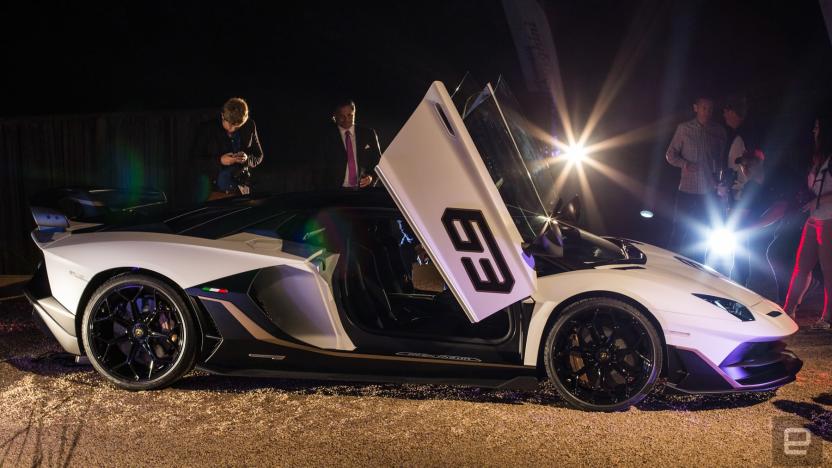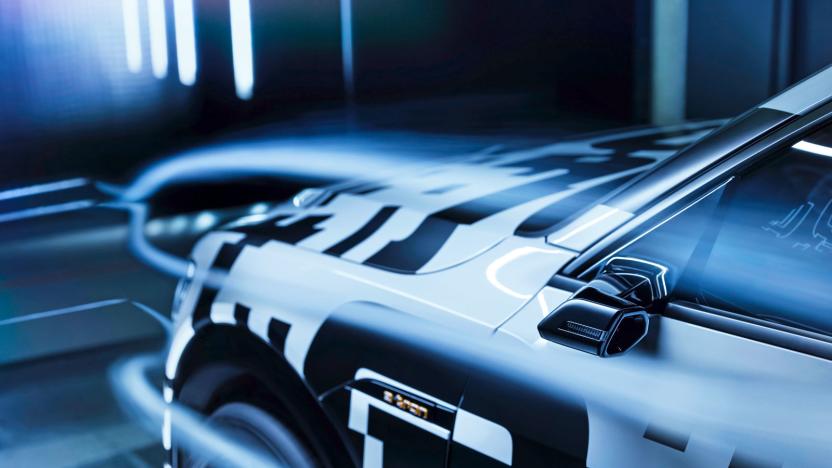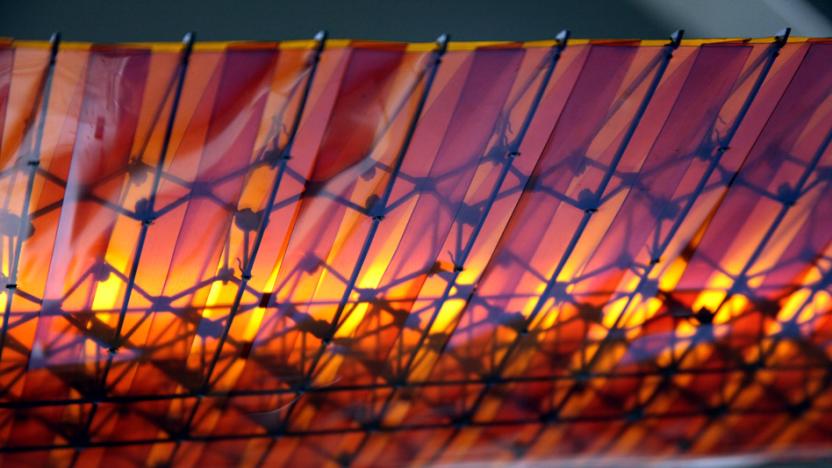aerodynamics
Latest

Lamborghini’s Aventador SVJ bests its siblings in downforce
Last month I drove a Huracan Performante and marveled at the aerodynamic wizardry the automaker used to keep the supercar glued to the asphalt. Called ALA (Aerodinamica Lamborghini Attiva), the dynamic airflow system can create downforce on the both or either side of the vehicle. It's great.

Audi e-tron's optional side cameras will help maximize range
Audi has a novel way to reduce drag and maximize the range of its electric e-tron SUV: it plans to offer an option to nix side mirrors. Instead, the car can use cameras, and display images from them on OLED screens between the instrument panel and the door. Opting for cameras instead of mirrors cuts the car's width by just under six inches, reducing both drag and wind noise. The "virtual exterior mirrors" are also adaptable depending on your situation -- they can be optimized for highway driving, turning and parking.

MIT and NASA's flexible wing could be the future of aviation
A wing is one of the most technologically advanced pieces of an aircraft, designed with all manner of moving parts that take advantage of the Bernoulli Principle. Previous efforts to make the wing more flexible, like a bird's, have run into snags too. "The biggest problem was that most of these attempts relied on deforming the wing through the use of mechanical control structures within the wing," MIT News writes. "But these structures tended to be so heavy that they canceled out any efficiency advantages produced by the smoother aerodynamic surfaces." More than that, they apparently made the wing more complicated and had some issues with reliability.

Formula 1 aerodynamics will make grocery stores more efficient
No, that's not a typo. It turns out Formula 1 racing technology, specifically aerodynamics, can help rid grocery stores of the so-called "cold aisle" issue. Using aerofoils that are designed to guide the direction of air flow around a race car, Williams F1's engineering department and UK start-up Aerofoil Engery aim to keep the cool temps inside the open refrigerators at the market. The aerofoils attach to each shelf, guiding the cold air so that not only is that section more comfy for shoppers, but energy use is reduced as well. In fact, Sainsbury's, the second largest grocery store chain in the UK, is already testing the tech. "This Formula 1 inspired innovation has already shown it can cut carbon produced by major refrigerators," said John Skelton, the retailer's head of refrigeration. The project is still in the testing phase, so if could be a while before its ready for widespread installation.

Future cars may give themselves dimples to reduce drag
Golf balls are dimpled for a reason -- they sail through the air just slowly enough that the uneven surface reduces drag, helping them fly farther than they might otherwise. Wouldn't it be nice if your car could get that kind of aerodynamic boost? It might, if MIT's newly developed morphable surface becomes a practical reality. The technology creates dimples on the fly by sucking the air out of a hollow ball with both a stiff, rubber-like skin on top and a soft material just below. The result is odd-looking to say the least, but it's effective. It can wrinkle itself to cut down on air resistance when it's traveling slowly, yet smooth itself out to minimize drag at high speed.

Volkswagen's XL1 concept plug-in diesel hybrid has 260MPG fuel efficiency, questionable aesthetics
Steaming down the autobahn could be about to get a whole lot more efficient. Volkswagen has carted out its newly updated Super Efficient Vehicle concept, now dubbed the XL1, which -- after a great deal of fuzzy math, we're sure -- is rated at a 313MPG fuel efficiency and produces only 24g of CO2 per kilometer traveled. There's an electric motor and a TDI diesel engine making all the buzzing and roaring noises inside, while the overall body design is focused on making the car as light and as aerodynamic as possible. Volkswagen has achieved a 795kg curb weight by using carbon fiber, magnesium, ceramics, and aluminum to shave down any excess portliness from the XL1, while wind-tunnel testing and optimizations have resulted in a rather exemplary 0.186 drag coefficient. It's rare to see such attributes on anything outside the supercar realm, but then there's a reason why this PHEV is still only a concept. FOF. Update: Oh bother. Turns out Volkswagen's mileage claim is based on Imperial gallons, which are 1.2 times the size of the American stuff, meaning that the XL1 actually measures in at 260MPG when viewed through US glasses. Now do you see why the rest of the world has gone metric?

125cc motorcycle + DIY fiberglass fairing = 214mpg, super cool looks
While the quest for alternate fuels goes on, so too other peoples' search for the ultimate in economy while running on good 'ol petrol. Allert Jacobs DIY creation reaches near the pinnacle of two-wheeled efficiency, almost doubling the stock Honda Innova 125i's 114mpg rating. He hand-crafted the fiberglass shell above, which slides forward to allow easy egress and looks rather close to the dustbin fairings post-WWII race bikes used to achieve incredible speeds -- before they were banned in 1958 due to crosswind instability. No word on what Jacobs' creation is like to ride in a stiff gale, but we must say his bike looks rather more badass than the stock model. [Photo credit: Hans Pieterse]

World Cup ball gets NASA's official mark of disapproval
If you've been following World Cup tourneys through the noughties, you'll have noticed that criticizing the official tournament ball has turned into something of an unspoken tradition. The latest offender of football purists' stringent standards is the Adidas Jabulani ball, which was introduced especially for World Cup 2010. That wouldn't be notable in itself, but this time it's apparently gotten bad enough for NASA to pipe up and drop some science on the subject. The aerodynamics experts (at least we hope they're experts) of the American space agency have said that the 440-gram ball becomes unpredictable when propelled at over 44mph, resulting in the unnatural swerves and deviations that have been plaguing footballers this year. So there you have it, England, Italy and France: a rock solid excuse to pin your lackadaisical exhibitions of mediocrity this year -- it was the ball's fault.

Inhabitat's Week in Green: surfing renewable energy, hexagonal LEDs, and ultra-efficient aerodynamics
The Week in Green is a new item from our friends at Inhabitat, recapping the week's most interesting green developments and clean tech news for us. This week Inhabitat reported live from the scene of New York Design Week, where we sifted through thousands of new home furnishings and interiors products to bring you the state-of-the-art in green design. Fresh from the floor of the International Contemporary Furniture Fair is this stunning hexagonal crystal LED light, which is composed of glowing geometric blocks that snap together to form a myriad of shapes. We were also impressed by this beautifully finished wood calculator that multiplies its green factor with sustainably-sourced materials. The past week was also surging with developments from the field of renewable energy - first we were excited to see the unveiling of the Oyster 2, an offshore wave-harvesting energy plant that improves upon its predecessor with a simpler design, fewer moving parts, and a 250% increase in energy generation. Google, HP, and Microsoft are also getting into the green energy game with plans to tap an unexpected energy source to run their data centers - cow dung! Google also led the charge towards cleaner energy this week by funding a new type of jet engine-inspired geothermal drill that uses superheated streams of water to bore through previously impenetrable surfaces. Speaking of jets, MIT has just unveiled several ultra-efficient airplane designs that are capable of cutting fuel use by a whopping 70%. The auto industry also received a jolt of energy as Toyota announced a partnership with Tesla that will boost California's flagging economy and likely lead to more affordable iconic electric vehicles. The field of wearable technology saw several innovative advancements this week as well - safe cyclists rejoice, because a group of Indian students have designed a $22 Solar and Wind Powered Bike Helmet. Meanwhile, a group of Colorado State University seniors have designed a medical incubator backpack unit that they believe can reduce baby deaths in medical emergencies. Finally, we shined light on several brilliant advancements from the field of solar technology, starting with China's plans to build the "biggest solar energy production base" in the world. We also looked at the HYDRA, a solar-powered hydrogen fuel cell system that can reportedly generate 20,000 gallons of pure water a day, and green energy got literal with the unveiling of the first leaf-shaped crystalline silicon solar panels.





